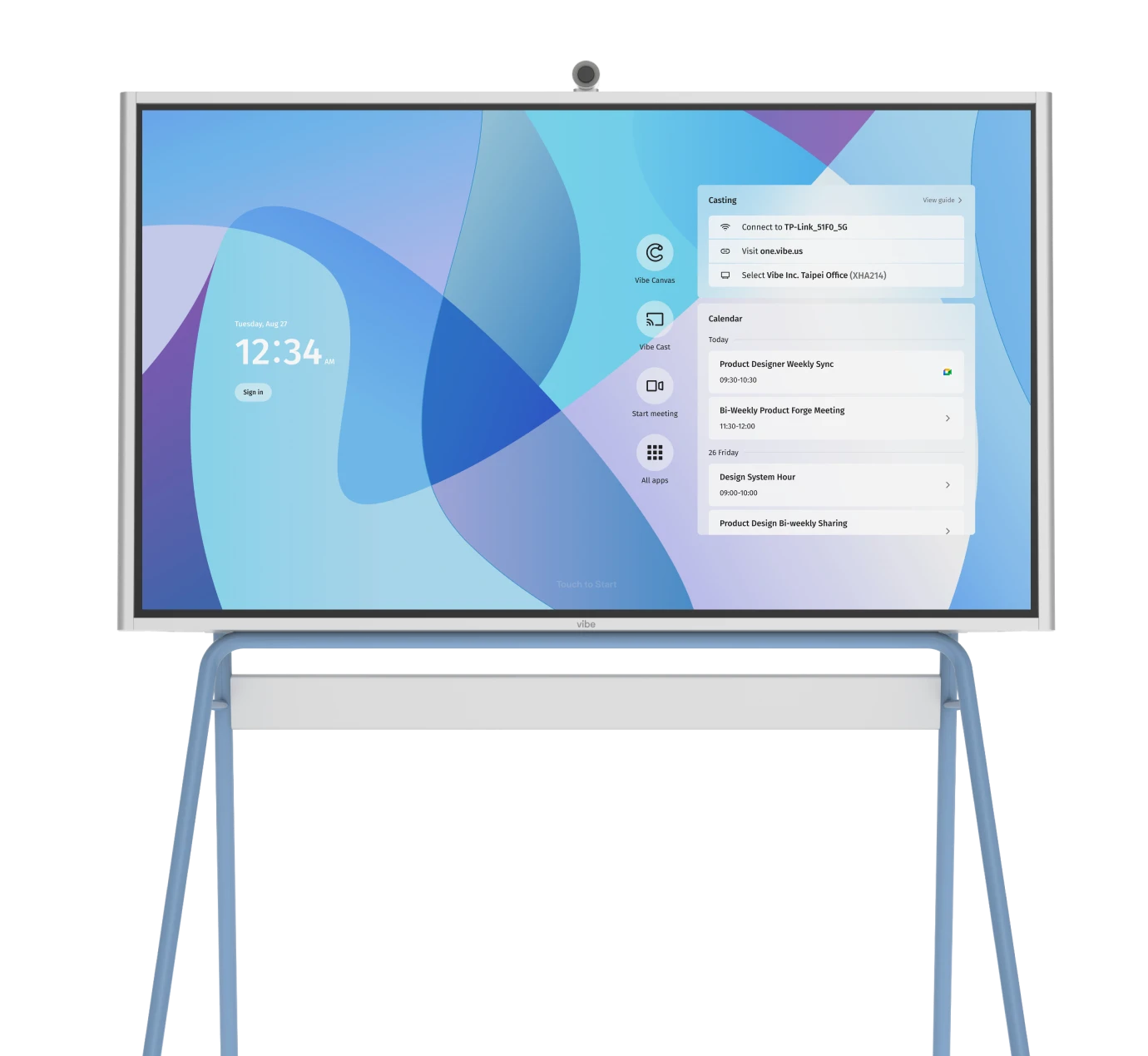The growing popularity of remote and hybrid work has transformed how teams collaborate across all industries. Gone are the days when brainstorming required everyone to gather in the same room around a physical whiteboard. Today’s business needs demand more flexible solutions connecting team members regardless of location. As organizations embrace hybrid work models, digital whiteboarding tools have emerged as essential collaboration platforms that foster creativity, enhance productivity, and streamline communication across distributed teams.
What is a Digital Whiteboard?
A digital whiteboard is a cloud-based platform that allows participants to collaborate in real time by contributing ideas, sketches, and notes to a shared virtual canvas. Unlike traditional whiteboards that require physical presence, digital whiteboards enable anyone to participate from anywhere in the world using their own devices online. These platforms eliminate the imbalance that occurs in hybrid meetings where in-room participants have easier access to physical whiteboards while remote team members struggle to contribute effectively. Digital whiteboards support various collaboration activities including brainstorming, planning, design reviews, and educational instruction, making them versatile tools for modern distributed workplaces. They preserve meeting information digitally, allowing teams to revisit ideas and continue effective collaboration asynchronously after live sessions end.
Key Features to Look for in an Online Whiteboard Solution
When evaluating digital whiteboard platforms, certain features distinguish truly effective solutions from basic drawing tools. The following capabilities create powerful collaboration experiences that transform how teams work together across distances and time zones. Understanding these key elements will help you select a platform that meets your team’s specific needs while providing room for growth as your collaboration practices evolve.
An Unlimited Canvas
Digital whiteboards provide expansive, scrollable canvases that extend far beyond the constraints of physical boards. This unlimited space allows teams to capture extensive brainstorming sessions without running out of room. Teams can zoom in for detailed work or zoom out for a comprehensive overview of all ideas. The flexibility of an infinite canvas encourages more comprehensive ideation and complex mapping of concepts. This feature is particularly valuable for large-scale planning sessions or projects with multiple interconnected components.
Real-time Information Syncing
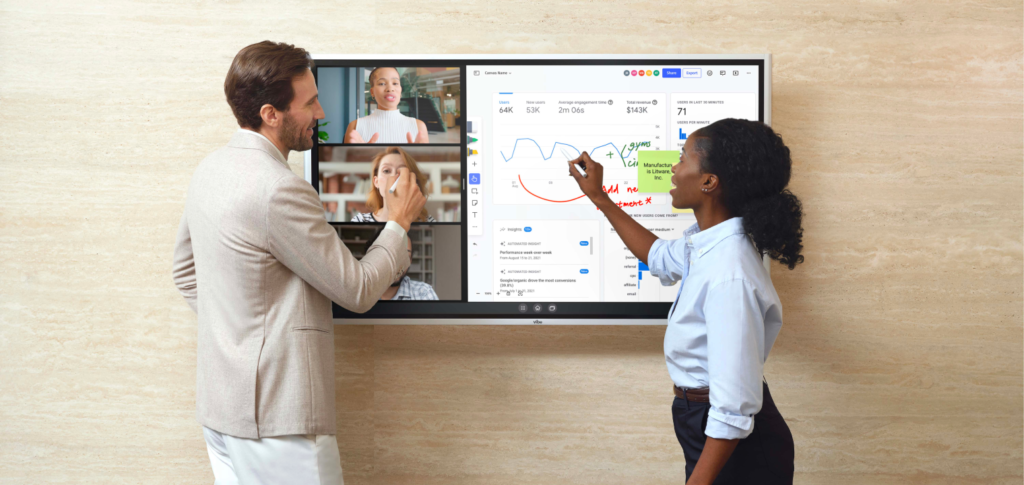 Diverse team aligning project ideas during hybrid in-person and virtual collaboration session.
Diverse team aligning project ideas during hybrid in-person and virtual collaboration session.Effective digital whiteboards update content instantly across all participant devices, ensuring everyone sees the same information simultaneously. This synchronization eliminates confusion and keeps all team members aligned throughout collaborative sessions. Real-time syncing enables immediate feedback on ideas, allowing teams to iterate quickly and maintain productive momentum. The instantaneous nature of these updates creates a dynamic environment that closely mimics in-person collaboration while extending its capabilities beyond physical limitations.
Cloud-based Storage
Cloud storage capabilities ensure that whiteboard content remains accessible long after meetings conclude. Teams can save their work automatically without manually copying information, eliminating the risk of losing valuable ideas. This persistent storage allows participants to revisit and build upon previous work, creating continuity across multiple sessions. Cloud-based solutions also enable easy sharing with stakeholders who weren’t present during the original collaboration, extending the reach and impact of team efforts.
Color-coded Contributions
Digital whiteboards use color coding to identify each participant’s contributions, making it easy to track who added specific ideas. This visual distinction helps teams understand the origin of concepts and facilitates proper attribution of ideas. Color coding also assists in post-meeting analysis, allowing leaders to ensure all team members have opportunities to contribute. This feature promotes accountability and recognition while helping teams identify patterns in how different members approach problems.
Templates for Easy Organization
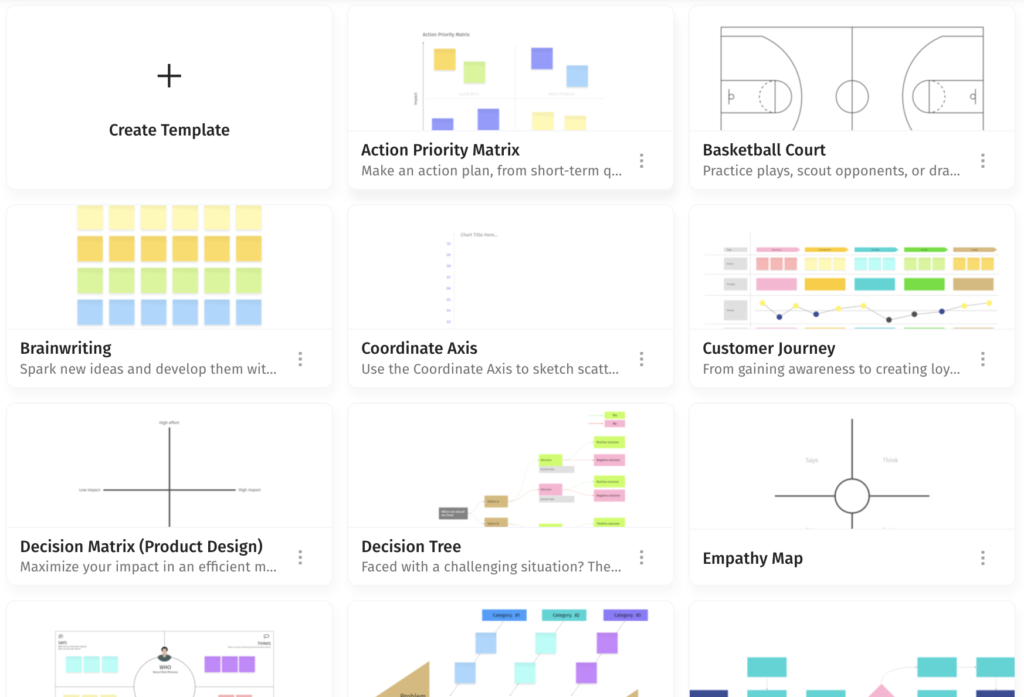 A fraction of ready-to-use templates provided by Vibe Canvas.
A fraction of ready-to-use templates provided by Vibe Canvas.Pre-designed templates provide structured frameworks that help teams organize information logically and efficiently. These templates support various collaboration activities including brainstorming, planning, retrospectives, and decision-making processes. Using templates reduces setup time and ensures consistent organization across different sessions and teams. They also help guide participants through established methodologies, making complex collaboration processes more accessible to everyone regardless of experience level.
Comment, Polling, and Feedback
Advanced digital whiteboards include communication features that facilitate discussion directly within the platform. Commenting capabilities allow participants to provide context, give feedback, or ask questions about specific elements without interrupting the flow of collaboration. Polling tools enable quick consensus-building and decision-making, accelerating the path from ideation to action. These integrated feedback mechanisms create richer, more nuanced collaboration experiences that capture both visual concepts and the discussions surrounding them.
Media Upload and Annotation
The ability to import and annotate existing files transforms static documents into interactive collaboration spaces. Teams can upload images, PDFs, spreadsheets, and other media to provide context or serve as starting points for discussion or design reviews. Annotation features allow participants to highlight important elements, suggest changes, or add explanatory notes directly on imported content. This capability bridges the gap between formal documentation and collaborative ideation, creating a more integrated workflow.
Secure Access Anywhere
Digital whiteboards implement security measures that protect sensitive information while maintaining accessibility for authorized users. Secure login systems ensure only invited participants can view and edit whiteboard content, protecting proprietary information. This security extends to remote access capabilities, allowing team members to contribute safely from any location with internet connectivity. The combination of robust security and flexible access creates a protected environment for collaboration without geographical limitations.
AI Tools
Modern digital whiteboards increasingly incorporate AI capabilities that enhance human creativity and productivity. These tools can automatically organize information, suggest connections between ideas, clean up messy handwriting, or transform rough sketches into polished graphics. AI assistants can help summarize discussions, create action items, or generate starting points for brainstorming sessions. These intelligent features augment human capabilities without replacing the essential creative input that drives meaningful collaboration.
Hybrid Device Accessibility
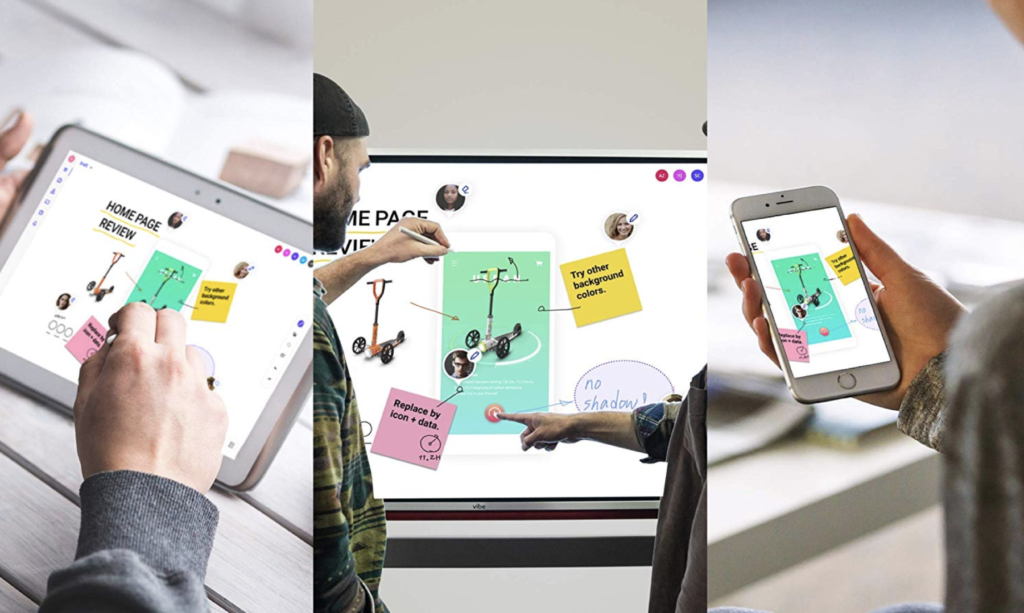 Vibe canvas displayed across multiple devices showing seamless content sharing via single link.
Vibe canvas displayed across multiple devices showing seamless content sharing via single link.The best digital whiteboard solutions work seamlessly across various devices, accommodating different work preferences and environments. Teams can access and contribute to whiteboards using touchscreens, styluses, keyboards, or mice depending on their available hardware. This flexibility ensures that participants can engage effectively whether they’re using dedicated smart whiteboard hardware, laptops, tablets, or smartphones. Device-agnostic platforms remove technical barriers to participation, creating more inclusive collaboration experiences.
6 Top Digital Whiteboard Options
Finding the right digital whiteboard for your team requires understanding each platform’s unique strengths and specializations. We’ve evaluated the leading options to help you identify which solution best matches your collaboration needs. Let’s explore how these 6 top contenders compare across key functionality areas:
-
Vibe Canvas – Best all-around solution with an infinite canvas, cloud storage, and seamless transitions between devices for both remote, hybrid, and in-person collaboration.
-
Mural – Best for highly visual team collaboration with excellent templates for discovery calls, requirements gathering, and problem-solving analysis in fully remote environments.
-
FigJam – Best for design teams who need a lightweight, intuitive whiteboard that connects directly to Figma’s design ecosystem.
-
Miro – Best for complex analysis, co-creation, and workshop facilitation with frameworks that support large-scale planning and strategy development.
-
Canva – Best for creating visually polished whiteboards with AI-powered organization features and simple integration with Canva’s extensive design assets.
-
Stormboard – Best for data-driven collaboration with detailed analytics, reporting capabilities, and bi-directional integrations with project management tools.
1. Vibe Canvas
Vibe offers a comprehensive digital whiteboard solution that combines intuitive software with purpose-built hardware options. The Vibe Canvas software features an infinite canvas with real-time collaboration capabilities that support both synchronous and asynchronous teamwork. Its clean interface and versatile functionality make it easy to adopt across various industries and teaching environments. The platform’s user-friendly design allows for quick implementation in corporate settings, educational institutions, and creative fields alike.
Vibe’s ecosystem integrates with popular productivity tools including Zoom, Microsoft Teams, Google Workspace, and Slack, creating a seamless workflow. The platform excels at supporting hybrid teams with features specifically designed to balance participation between in-room and remote collaborators.
Vibe’s hardware options, including large interactive smart whiteboards like the Vibe Board S1, provide an exceptional tactile experience while maintaining full compatibility with existing devices.
2. Mural
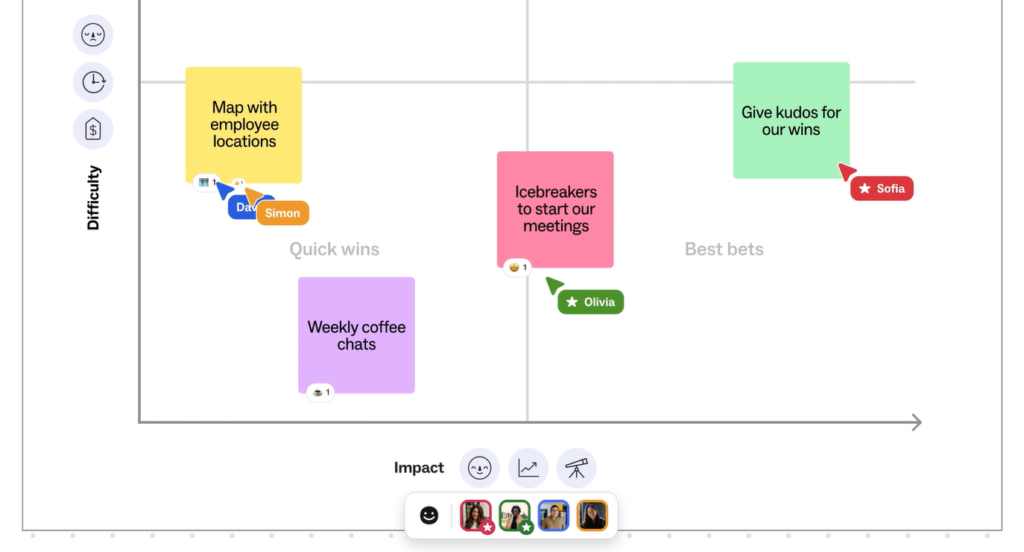 Digital whiteboard showing team members actively collaborating on a Mural canvas with visual diagrams and sticky notes.
Digital whiteboard showing team members actively collaborating on a Mural canvas with visual diagrams and sticky notes.Mural provides a visually oriented collaboration platform with extensive template libraries for various business processes. The platform emphasizes facilitation tools that help leaders guide productive sessions and ensure equal participation. Mural’s strengths include enterprise-grade security features and robust integration capabilities with business software ecosystems. The platform works particularly well for design thinking exercises and strategic planning sessions that benefit from visual organization.
3. FigJam
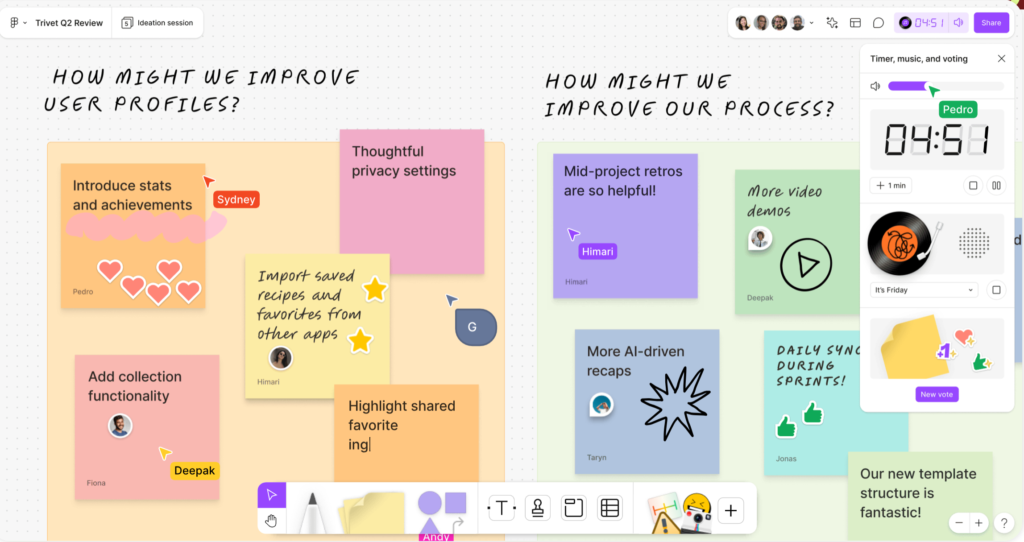 Team members brainstorming with sticky notes and diagrams on a Figjam collaborative whiteboard during a remote design session.
Team members brainstorming with sticky notes and diagrams on a Figjam collaborative whiteboard during a remote design session.FigJam offers a lightweight, design-focused whiteboard that excels at creative collaboration and wireframing. The platform features an approachable interface that makes it accessible to non-designers while still providing powerful tools for visual thinkers. FigJam integrates seamlessly with Figma, creating a smooth transition between ideation and implementation for design teams. The platform’s playful elements, including stickers and emotes, encourage engagement and create a more enjoyable collaboration experience.
4. Miro
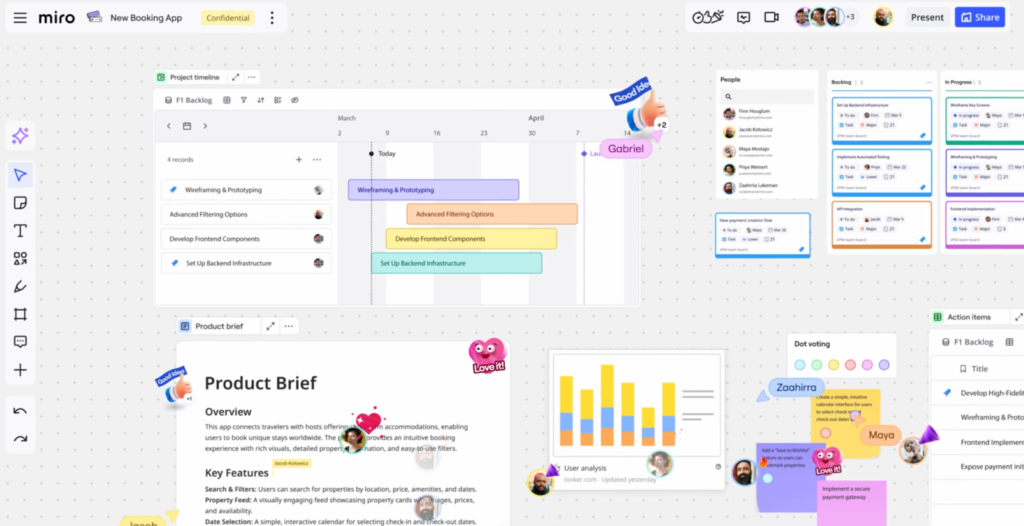 Team members interacting with a Miro digital whiteboard showing colorful sticky notes, diagrams, and connected ideas during a virtual collaboration session.
Team members interacting with a Miro digital whiteboard showing colorful sticky notes, diagrams, and connected ideas during a virtual collaboration session.Miro provides a versatile whiteboard platform with extensive integration capabilities and specialized tools for different workflows. The platform supports a wide range of use cases from agile development to UX research with dedicated templates and functionality. Miro’s developer APIs allow organizations to create custom integrations and extensions tailored to their specific needs. The platform balances accessibility for beginners with advanced capabilities for power users, making it adaptable to various team compositions.
5. Canva
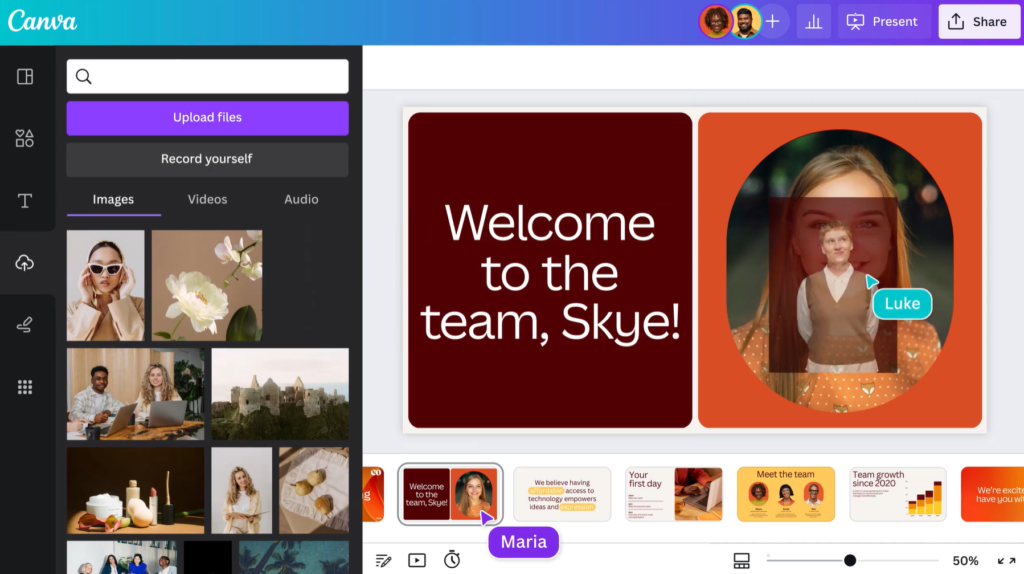 Team members adding digital sticky notes and ideas to a Stormboard virtual workspace during a remote brainstorming session.
Team members adding digital sticky notes and ideas to a Stormboard virtual workspace during a remote brainstorming session.Canva’s whiteboard solution leverages the platform’s extensive design assets to create visually polished collaboration spaces. The platform excels at creating presentation-ready outputs directly from whiteboard sessions without requiring additional design work. Canva’s extensive media library provides ready-to-use graphics, photos, and illustrations that enhance visual communication. The platform’s familiar interface makes it particularly accessible to teams already using Canva for other design needs.
6. Stormboard
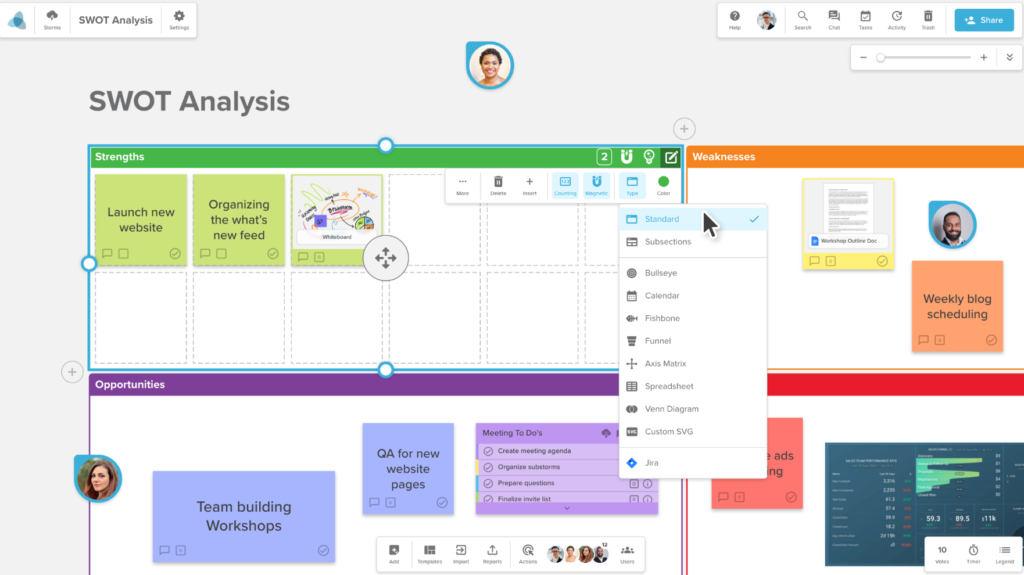 Team members adding digital sticky notes and ideas to a Stormboard virtual workspace during a remote brainstorming session.
Team members adding digital sticky notes and ideas to a Stormboard virtual workspace during a remote brainstorming session.Stormboard combines whiteboard functionality with structured idea management to help teams organize and prioritize concepts. The platform uses a sticky-note metaphor that makes it intuitive for users transitioning from physical brainstorming methods. Stormboard’s reporting features help teams analyze collaboration patterns and extract actionable insights from sessions. The platform works particularly well for structured brainstorming methodologies that require categorization and voting on ideas.
Benefits of Using Digital Whiteboards
The adoption of digital whiteboarding solutions creates incredible advantages that extend far beyond simple drawing capabilities. Organizations implementing these tools report significant improvements in team dynamics, knowledge management, and overall productivity. These benefits compound over time as teams develop more sophisticated collaboration practices and integrate online whiteboarding into their regular workflows. Here’s how online whiteboards create lasting value for modern organizations:
Improved Collaboration
Digital whiteboards eliminate the physical limitations that traditionally restricted collaboration, allowing everyone to contribute equally regardless of location. These platforms support multiple simultaneous contributors, dramatically increasing the volume and diversity of ideas generated during sessions. The visual nature of whiteboarding helps teams develop shared understanding more quickly than text-based communication alone. Digital collaboration tools also accommodate different thinking and communication styles, creating more inclusive environments where everyone can participate effectively.
Remote Accessibility
Online whiteboards enable global teams to collaborate in real-time without travel, reducing costs and environmental impact. Remote accessibility expands talent pools by removing geographical restrictions on hiring and team formation. These platforms support both synchronous and asynchronous collaboration, accommodating different time zones and work schedules. The ability to participate from anywhere increases meeting attendance and engagement, ensuring important voices aren’t excluded due to location constraints.
Information Preservation
Digital whiteboards automatically save content, eliminating the risk of losing valuable ideas when physical boards are erased. Saved sessions create organizational knowledge repositories that preserve insights and prevent redundant work. The ability to revisit previous sessions allows teams to track progress and build upon earlier ideas rather than starting from scratch. Digital preservation also creates accountability by maintaining records of decisions and commitments made during collaborative sessions.
Higher Engagement
Interactive features like drawing, voting, and commenting create more engaging experiences than passive meeting participation. The visual and tactile nature of digital whiteboards activates different cognitive processes than verbal discussion alone, leading to more creative thinking. Real-time feedback mechanisms provide immediate validation that encourages continued participation and idea sharing. The creative aspects of many whiteboard platforms reduce meeting fatigue making collaboration more engaging and increasing willingness to participate.
Enhanced Productivity
Templates and organizational tools reduce setup time and help teams follow established methodologies efficiently. Digital whiteboards streamline the transition from ideation to action by integrating with project management and productivity tools. The ability to import existing content eliminates redundant work and creates continuity between different phases of projects. Automated documentation features reduce administrative overhead, allowing teams to focus on creative and strategic thinking rather than note-taking.
Software Integration
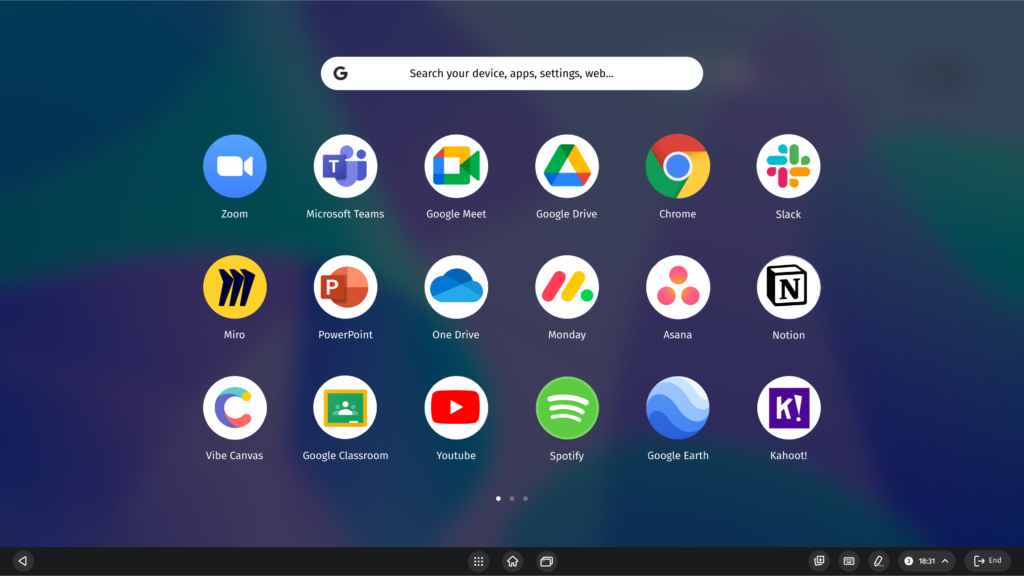 Vibe digital whiteboard interface displaying various integrated productivity apps and tools that enable seamless workflows between platforms for collaborative teamwork.
Vibe digital whiteboard interface displaying various integrated productivity apps and tools that enable seamless workflows between platforms for collaborative teamwork.Leading digital whiteboards connect with popular productivity tools, creating seamless workflows between platforms. These integrations enable teams to move ideas directly from whiteboarding sessions into actionable tasks in project management systems. Connected ecosystems reduce context switching and information loss between different stages of work. The ability to pull information from various sources into whiteboard sessions provides a richer context for decision-making and planning.
Digital Whiteboards vs Physical Whiteboards
Digital whiteboards overcome the space limitations of physical boards, providing infinite canvases that accommodate extensive collaboration. While physical dry erase boards only serve in-room participants, digital platforms enable equal participation regardless of location, supporting hybrid and remote teams. Digital solutions automatically preserve all content, eliminating the "take a picture before erasing" scramble common with physical boards. Physical whiteboards require additional equipment and effort to share content with absent team members, while digital platforms make sharing instantaneous and effortless. Digital whiteboards support multimedia content including videos, documents, and web content that cannot be incorporated into physical boards. While physical boards offer tactile simplicity, digital platforms provide significantly greater functionality, flexibility, and inclusivity for modern collaborative work.
Digital Whiteboards vs Interactive Whiteboards
Digital whiteboards are software platforms accessible from any device, while interactive or smart whiteboards combine specialized hardware with software capabilities including online whiteboards. Interactive whiteboards typically require investment in fixed equipment, paired with digital whiteboard software that works with employees’ existing devices. Digital solutions offer greater flexibility for distributed teams, while interactive whiteboards provide enhanced in-room experiences for co-located participants. Many organizations implement hybrid approaches, using interactive displays to access digital whiteboard software, combining the benefits of purpose-built hardware with cloud-based collaboration. Interactive whiteboards excel in dedicated collaboration spaces, while digital whiteboard software adapts to any environment from on-the-go work to conference rooms. We have found that the best choice between these options ultimately is a combination of the two but depends on your team distribution, budget considerations, and specific collaboration requirements.



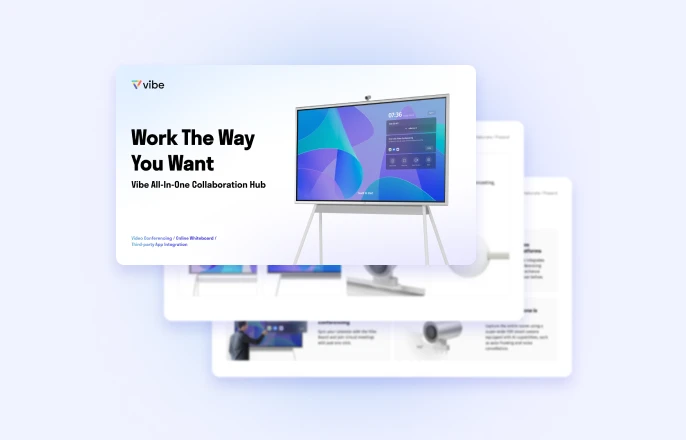
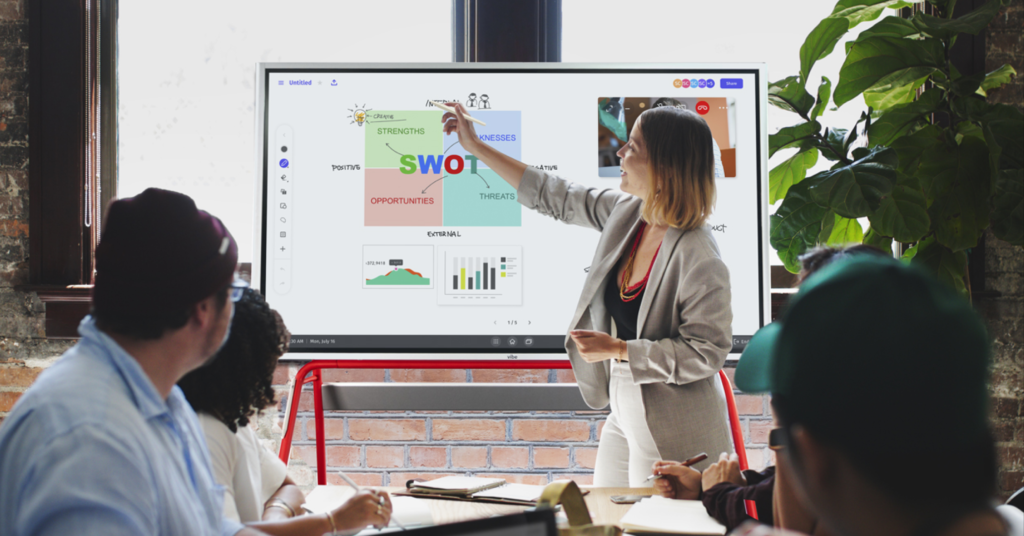



-1sbltxxq4FYxHrXrwJVLsCDNsXpqNa.webp)
-5Zp0pmSytvcuYDVs1LvuwplKuRneK0.webp)
